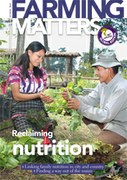Improving family nutrition is the primary goal of family farmers, though how they strive to do so varies considerably. As we see here, increasing crop diversity on their farms and growing more traditional varieties are two ways, but increasing livestock production is another that can also have huge impacts.
India: The rich diversity of forest foods
“It is a massive crisis, a crisis that is not of our making. I fear our whole life, livelihood and culture may be lost forever if we do not start educating our children and future generations to conserve nature, live harmoniously with the seasons, and revive our traditional and biodiverse nutritional security.” This poignant lament of a tribal woman sums up the motivation behind the Tribal Food Festival held in February 2014 at Bissam Cuttack in Odisha, India.
The festival showcased traditional food culture and age-old agricultural practices of the Adivasi communities. Over 600 Adivasis, mostly women from more than 200 tribal villages from all over eastern and central India, came to celebrate the rich diversity of their traditional food culture.
More than 1500 foods and dishes were on display, with 900 from wild forest plants. The festival was a vibrant celebration of food and culture, Debjeet Sarangi of Living Farms, one of the organisers explains. “A wealth of living knowledge yet exists in our indigenous communities regarding their forest bio-resources.” If such practices are nurtured and improved, they would provide far better food and nutrition security than the current public distribution system, and also help the communities and the forests protect each other.
For more information, contact Bharat Mansata, writer and editor affiliated with Earthcare Books (bharatmansata@yahoo.com).
The Gambia: Collective milk and manure
In 1997, falling groundnut yields and prices led 60 families in the Upper River Region of the Gambia to start the Misera Livestock Farmers Association (MLFA). Seeking to increase their incomes, they began to collectively manage a farm, supported by the Women’s Bureau, the Department of Livestock Services, and the Livestock and Horticulture Development Project. Membership has grown to 100 families and besides farming together, a communal spirit is thriving thanks to social and religious gatherings. Their focus on local breeds of sheep and goats has also led to other benefits.
“This initiative not only improves our income, it is also improving the quality of our diets,” says Tida Danso. Income is generated from live animal sales, while up to two litres of milk per day became available for the children. The collective is now increasing the number of breeding animals, and planting more fodder trees such as Leuceana leucocephala and Moringa oleifera.
The manure has also doubled vegetable yields, so much more cabbage, sorrel, onion, okra, pepper and tomatoes now ends up on family plates and are not just for market, leading to a huge increase in dietary diversity. The group’s focus on nutrition is expanding, now involved in a project focusing on infant nutrition.
For more information, contact Olawale Olaniyan (ofolaniyan@hotmail.com) and Fafa Cham (foc1972@gmail.com).
Afghanistan: Female farmer poultry schools
In Afghanistan, imports of meat, poultry, eggs, cereals and even fruit and vegetables have become the order of the day. This has exacerbated poor nutrition experienced by vulnerable rural households. Empowered women producing local food are a strong link between increased production and nutritional improvements. Starting in 2010, a backyard poultry development project, funded by International Fund for Agriculture Development (IFAD) through the Rural Microfinance and Livestock Support Program of the Ministry of Agriculture, Irrigation and Livestock, highlights this critical link.
The project was built upon a participatory approach to training through female farmer poultry schools (FFPS). Women were empowered to take the necessary decisions to begin rearing poultry. These poultry schools also ensured that practical and affordable solutions to challenges with housing and feeding were developed. Some examples are halving winter feeding costs with hydroponic barley, wheat and sprouted pulse forages, and using readily available resources like mud and old plastic cans to make nests and coops. Today, 6000 village women are each producing and selling up to 2500 eggs every day, translating into income and food for their families as well as visible nutritional gains especially for young children.
For more information, contact Mohammad Jafar Emal, national poultry advisor at the Ministry of Agriculture, Irrigation and Livestock, Afghanistan (jafar.emal@hotmail.com).
East Timor: Healthy poultry make for healthy people
One egg can provide nearly half the recommended daily protein needs for children under three, and undernutrition is reduced more efficiently with access to optimal combinations of food from both animal and plant sources. Francisca José, a farmer from Aileu District explained that “If we don’t have money, we sell chickens to buy food and school materials. If we had more and healthier chickens, we could sell some and eat some. We eat chicken only once a month but with more we can have more eggs and eat meat more often.” But there is a problem –diseases causing high levels of chicken mortality, and especially Newcastle disease can kill virtually all the birds in a whole village. Farmers then keep many eggs to replace dead birds.
Poultry are often owned and managed by women so training in vaccination and management was planned with this in mind, with more female extension agents from the Ministry of Agriculture, encouraging gender balance in community vaccinators, and village-level training reducing the need for child care. Improved poultry production strengthens household food and nutrition security, reduces poverty, and benefits are also felt in urban communities when farmers can sell more birds and eggs.
For more information, contact Robyn Alders at the University of Sydney (robyn.alders@sydney.edu.au).

